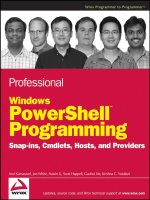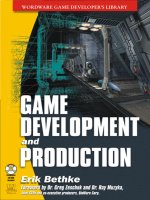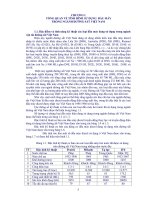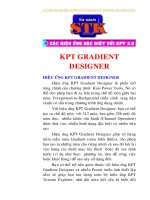Tài liệu Game Development Production P1 ppt
Bạn đang xem bản rút gọn của tài liệu. Xem và tải ngay bản đầy đủ của tài liệu tại đây (426.47 KB, 30 trang )
TEAMFLY
Team-Fly
®
Game
Development and
Production
Erik Bethke
Wordware Publishing, Inc.
Library of Congress Cataloging-in-Publication Data
Bethke, Erik.
Game development and production / by Erik Bethke.
p. cm.
ISBN 1-55622-951-8
1. Computer games--Design. 2. Computer games--Programming.
3. Project management. I. Title.
QA76.76.C672 B47 2002
794.8'1526--dc21 2002153470
CIP
© 2003, Wordware Publishing, Inc.
All Rights Reserved
2320 Los Rios Boulevard
Plano, Texas 75074
No part of this book may be reproduced in any form or by any means
without permission in writing from Wordware Publishing, Inc.
Printed in the United States of America
ISBN 1-55622-951-8
10987654321
0301
Product names mentioned are used for identification purposes only and may be trademarks of their respective
companies.
All inquiries for volume purchases of this book should be addressed to Wordware Publishing,
Inc., at the above address. Telephone inquiries may be made by calling:
(972) 423-0090
Contents
Foreword ...............................xvii
Preface ................................xix
Acknowledgments ..........................xxi
Part I—Introduction to Game Development
Chapter 1
What Does This Book Cover? ............3
How to Make a Game..........................3
First Have a Plan ............................3
Organize Your Team Effectively ....................4
Game Development Is Software Development ............4
Where to Turn for Outside Help ....................4
How to Ship a Game ..........................5
Post-Release ..............................5
Success and the Long Race ......................5
How to Use This Book .........................6
Chapter 2
Why Make Games? ..................7
To Share a Dream............................7
Games Teach ..............................7
Game Genres Satisfy Different Appetites ..............8
Gambling, Puzzle, and Parlor Games................8
Military and Sports Simulations..................10
Role-Playing Games ........................12
Youth Making Games .........................13
On Money ...............................13
Why Make Games? ..........................14
Chapter 3
What Makes Game Development Hard? ......15
The Importance of Planning .....................15
Very Few Titles Are Profitable ....................15
500,000 Units to Break Even? ..................16
Employee Compensation and Royalties .............17
What Are the Financial Expectations for Your Game? .......17
The Scope of the Game Must Match Financial Parameters ...17
Why Your Game Should Profit ....................18
Feature Storm ...........................18
If the Game Is Worth Making, Make It Excellent ........19
iii
Excellence in Spades .........................19
Game Making Is a Long Race of Many Game Projects .......20
A Brief History of Software Development..............21
Overly Long Game Projects Are Disastrous ............21
What Late Games Do to the Publisher ..............22
Our Project Plan Behind Starfleet Command ............22
The Vision for Starfleet Command ................23
Constraints Give Much Needed Focus................24
On Bugs Shipped in Starfleet Command...............24
Well-Met Goals Enable Future Successes ..............25
Strong Game Developers Have Strong Foundations ........25
The Tension between Preproduction and Production........25
The Power of the Console ......................26
Why Aren’t All Publishers Using Preproduction?..........27
The Process Is Changing .....................27
A Strong Plan Makes Game Development Easy ..........28
The Gravitational Pull of Feature Creep ...............28
Task Visibility for Team Motivation and for Progress Tracking . . 29
Use Your Core Competencies and Outsource the Rest .......29
A Pitfall of Success—Fan-Requested Features and Changes....29
The Relentless Pace of Technology .................30
The Art of War and Games ......................32
Chapter 4
Game Project Survival Test .............33
The Game Project Survival Test ...................33
Game Requirements ........................33
Planning...............................33
Project Control ...........................34
Risk Management .........................35
Personnel ..............................35
Calculating Your Project’s Score .................35
What Does My Score Mean? ...................36
Part II—How to Make a Game
Chapter 5
What Is a Game Made Of? ..............39
The Extended Development Team..................39
Game Production Parts ........................39
Design Parts ............................39
Where Do Lead Designers Come From? ...........40
How Do You Nail Down the Game Mechanics? ........40
Who Are the Level and Mission Designers?..........40
Story and Dialogue Writers Are Writers for Interactivity...41
Coding Parts ............................41
Lead Programmers and Technical Directors..........42
Game Mechanics Programmer .................43
iv Contents
3D Graphics Programmer ...................43
Artificial Intelligence Programmer...............43
User Interface Programmer ..................44
Audio Programmer .......................44
Tools Programmer .......................44
Mission/Level Editor Programmer...............44
Network, Server, or Client Programmer? ...........45
ArtParts..............................45
Art Director ...........................46
Concept Artist ..........................46
2D Artist/Interface Designer ..................47
3D Modeler ...........................47
Character Modeler .......................47
Texture Artist ..........................48
Animator/Motion Capture Studio ...............48
Storyboarder...........................49
Audio Parts .............................49
Voice-Overs ...........................49
Sound Effects ..........................49
Music ..............................50
Management Parts .........................50
Line Producer ..........................50
Associate Producer .......................50
Studio Head/Executive Producer................51
Producer .............................51
Quality Assurance Parts .......................52
Publisher QA Parts.........................52
QALead.............................52
Main Team ............................53
Multiplayer Team ........................53
Fresh Teams ...........................53
Compatibility Team .......................53
Localization Team ........................53
Beta Testing ............................54
Beta Testers ...........................54
Beta Testing Program Manager ................54
Business Parts.............................55
Business Development Parts ...................55
Business Development Executive ...............55
Publisher CEO and President .................55
Studio Heads ..........................55
Lawyers .............................55
Licensing Parts ...........................56
Promoting, Buying, and Selling Parts...............56
Sales Executive .........................56
Contents v
Sales Force and Retail Purchasing Agents ...........57
Press Relations Manager ....................57
Trade Shows ...........................57
Other Trade Shows and Events ................58
The Marketing of a Game....................59
Hardcore Fans ..........................59
Manuals and Strategy Guides ...................60
Manual ..............................60
Strategy Guide .........................60
Manufacturing Parts ........................61
Hardware Manufacturer Parts ...................61
Console Manufacturers .....................61
Hardware Representatives ...................61
Post-Release Parts ..........................62
Chapter 6
Business Context First ...............65
The Project Triangle .........................65
Implications of the Project Triangle................66
Various Games and the Project Triangle .............67
Questions for You to Answer .....................70
What to Do with These Answers .................70
An Ultra-Low Budget Game ..................70
Fixed Budget, Fixed Deadline .................72
High-Profile/High-Quality Projects ..............73
WalkAway...............................74
Chapter 7
Key Design Elements ................75
Business Context Shapes Design, or Does Design Shape
the Business Context? ........................76
Reconcile the Business Context and Game Idea Early .......76
The Effects of a Slipped Game .................77
Methods and the Unified Development Process ..........81
What Is a Development Method? .................81
Why Use the Unified Software Development Process? .....81
Requirements Capture.......................82
Use Cases .............................82
Case Studies ..............................87
Case Study I—Diablo .......................87
Use Cases of Diablo .......................88
Quick Analysis of the Use Cases of Diablo ..........89
Case Study II—Gran Turismo ...................90
Use Cases of Gran Turismo...................92
Quick Analysis of the Use Cases of Gran Turismo ......93
The Key Design Elements of Your Game ............94
The Battle of the Counterterrorists Games ...........94
The Key Design Elements of Rainbow Six ..........95
vi Contents
Are We Playing a Mission or Planning a Mission?.......95
The Key Design Elements of Counter-Strike .........96
Most Popular Multiplayer Game ................96
Of Intersecting Sets and Elite Forces .............97
Some Straight Questions to Ask Yourself ..............99
What Genre or Genres Does Your Game Feature? ......99
Will the Game Be Single-Player, Multiplayer, or Both? ....99
What Is the Platform? ......................99
What Is Your Target Market? .................100
What Major Technologies Are You Using? ..........100
Now What? ..............................100
Chapter 8
Game Design Document ..............101
What Is a Game Design Document and What Does It Do? ....101
What About the Proposal Document? ...............102
When Do You Write the Game Design Document? ........103
What Should Go into a Game Design Document? .........105
Section One: Defining the Game ................106
Articulate What the Game Is as Clearly as Possible .....106
Set the Mood ..........................107
Section Two: Core Gameplay ..................107
The Main Game View .....................108
Core Player Activity ......................108
The Controller Diagram ....................108
In-Game User Interface ....................108
Section Three: Contextual Gameplay ..............109
Shell Menus ..........................109
The Nuts and Bolts of Game Mechanics ...........109
Tutorial Mechanics.......................109
Multiplayer Mechanics ....................110
Section Four: Talk Story .....................111
World Backstory ........................112
Character Backgrounds ....................112
Level, Mission, and Area Design ...............113
Cut Scene Descriptions ....................114
Section Five: Cover Your Assets ................115
2D Sprites or 3D Models ...................115
Missions, Levels, or Areas ..................115
Voice ..............................116
Key Framing and Motion Capture ..............117
Sound Effects .........................121
Music ..............................121
Special Effects .........................125
Stepping Back a Bit .........................127
Contents vii
Chapter 9
The Technical Design Document .........129
Object-Oriented Design .......................129
Purpose of the Technical Design Document ............130
Why Have a Software Development Process? .........132
The Unified Software Development Process ..........133
Core Workflows of the Unified Process............134
Phases of a Workflow in the Unified Process.........134
When Should the Technical Design Document Be Written? . . 135
What Goes into the Technical Design Document?.........136
Requirements Capture ......................136
Reverse Engineering .....................143
Nonobvious Requirements ..................143
Requirements Analysis ......................144
Class Diagram...........................145
Relationships..........................146
Drawing “is a” and “has a” Relationships and
Ordinalities...........................146
Adding Annotation .......................147
Other UML Diagram Types ...................147
Dynamic Modeling .......................148
Architectural Diagrams ....................149
Large-Scale Planning and the Evil of a Long Build Time ...150
Refactoring ...........................150
Insulation............................151
Forward and Backward Code Generation with a
Modeling Tool ...........................154
Testing Plan ............................154
Unit Testing and White Box Testing .............154
Black Box Testing .......................155
Beta Testing ..........................155
From Use Cases to Test Cases ................155
Chapter 10
The Project Plan...................157
What Is the Project Plan? ......................157
How Do We Create the Project Plan? ...............157
Gantt and PERT Charts for Organizing Project Tasks .....158
Focusing on the Gantt Chart .................160
Using the Technical Design Document ............161
Task Granularity and Task Leveling .............163
How Long Will That Task Take? ...............163
Short Time Estimate Possibilities ..............165
Estimating Research Tasks ..................165
Task Prioritization .......................166
Resource Leveling .......................171
Task Dependencies ......................172
viii Contents
The Top Ten Risks Document ..................174
The Non-Zero Chance of Delivery .................175
Chapter 11
Task Tracking ....................177
Production Begins—Now What? ..................177
Task Visibility ............................177
TheWall...............................177
Journals ................................179
The Cult of the Yellow Notebook ................179
Walk Around .............................180
Milestone Orientation Meetings ..................180
Praise People Publicly ......................180
Maintain the Gantt Chart ......................181
Update the Risks Chart .......................182
Chapter 12
Outsourcing Strategies...............183
Why Outsource? ...........................183
When to Think About Outsourcing .................184
What to Outsource ..........................185
Do Not Outsource Programming—Exceptions Noted .....185
On Outsourcing Art........................186
Movies, Cut Scenes, or Full Motion Video ..........186
3D Models—Modeling.....................187
Animation and Motion Capture ................187
User Interface Art .......................188
Audio................................188
Music ..............................188
Sound Effects .........................189
Voice-Over ...........................190
What Else to Outsource .....................190
Chapter 13
Shipping Your Game ................191
Shipping Is a Phase .........................191
How Do You Ship a Great Game? ..................191
Alpha—Feature Complete......................192
What Is Feature Complete? ...................192
Additional Content .......................192
Feature Trimming .......................192
Testing Plan .............................193
Publisher QA ...........................193
Team Testing ...........................194
Project Leader Testing ......................195
Automated Testing ........................195
Focus Group Testing .......................195
Beta Testing............................196
Open or Closed Beta Test? ..................196
Contents ix
Manufacturer Testing.......................197
Licensor Testing .........................198
How Do You Balance a Game? ..................198
Final Candidate Cycle ........................200
Transition, Ship, and Point Release .................200
Part III—Game Development
Chapter 14
The Vision Document ................205
Write the Vision Document Twice ................205
So Is the Vision Document a Proposal? .............206
Only 1 Percent Catch the Eye ..................206
What About the Precious Game Secrets? ..........207
Visuals .............................207
Tactile .............................208
What About the Words? ....................208
Contact Information ......................209
Chapter 15
Requirements Gathering ..............211
The Flavors of Requirements ..................211
Creative/License Requirements ...............211
Technical Requirements ....................212
Fiscal and Temporal Requirements ..............213
Use Case Diagrams ........................213
Chapter 16
The Design Document ...............215
What Does the Game Design Document Do? ...........215
The Game Design Document as a Process.............216
Game Concept ..........................216
Brainstorm ...........................216
Delegate Design ........................217
Managing the Design Document ...............218
60 Seconds of Gameplay....................218
Core Gameplay.........................219
The Walkthrough .......................220
Asset Lists ...........................221
Use of Other Games ......................222
Menu Design ..........................222
Game Mechanics Detail ....................223
Write the Manual? .......................223
Concept Sketches and Art Style Guide ............224
On Completeness and Uncertainty ..............224
Cut Features Even Before Considering the Schedule .....224
Maintain the Game Design Document .............225
On Fulfilled Expectations ......................225
x Contents
TEAMFLY
Team-Fly
®
Chapter 17
Unified Modeling Language Survival Guide ...227
Use Cases Deliver Requirements..................227
Class Diagrams Are the Keystone of Design............228
Detailed Syntax of the Class Diagram ...............230
Associations............................231
Attributes .............................232
Operations.............................232
Forward and Reverse Engineering of the Class Diagram .....233
The Other Seven Diagrams of UML ................238
Static Diagrams ..........................238
Dynamic Diagrams ........................240
Chapter 18
Technical Design ..................245
Nominate Functional Leads .....................245
Synthesize Use Cases and Nonvisible Requirements .......247
Start with the Use Cases.....................247
Casual, Frequent Design Review ...............247
Nonvisible Requirements ....................247
Measure Twice, Cut Once ....................249
Specify Tools, Languages, and Processes ............250
Goals for the Architecture ....................251
Identify Areas of Likely Change .................252
The Quality Assurance Plan.....................252
Defect Tracking ..........................252
Defect Tracking Software ...................253
The Testing Plan .........................253
How Many Bugs Are Left to Find? ..............254
Defect Pooling .........................254
Defect Seeding .........................255
Political Resistance ......................255
Automated Testing.......................256
Beta Testing ..........................256
When to Release the Game ..................257
Chapter 19
Time Estimates ...................259
Two Ways to Estimate a Task ....................260
Time Boxing ...........................260
Task Estimating..........................261
Art...............................261
Design .............................261
Programming..........................262
Each Shall Estimate Thy Own Tasks ..............264
Save Your Plans and Compare ..................264
Making the Plan ...........................264
Contents xi









